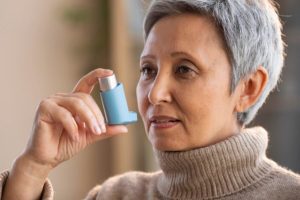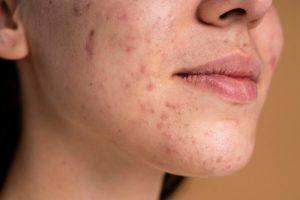Medical Journal Australia –
Controlled Buteyko Trial
At 3 months; Buteyko Group achieved
Reliever medication decreased by 90%
Call for free consultation:


Named after Dr Konstantin Buteyko, the Buteyko Method consists of a series of breathing exercises and guidelines specifically designed to reduce over-breathing (clinically known as ‘chronic hyperventilation’).
The simple fact is that many people breathe too much, which alters the natural levels of gases in the blood, reduces oxygen delivery to tissues and organs, and causes constriction of the smooth muscles surrounding blood vessels and airways.
This can lead to numerous health problems such as:




At 3 months; Buteyko Group achieved
Dr. Buteyko saw that sick people breathe hard, so he asked himself, “Is the sickness causing the hard breathing, or is the hard breathing causing the sickness?”
People are often told to take deep, full, big breaths in the belief that this will increase oxygen delivery to the tissues. If we look at the science, it doesn’t work that way. If you take big breaths, that increases the volume of air beyond what it should be, and you exhale too much carbon dioxide.
Due to the Bohr Effect (first described by the Danish biochemist Christian Bohr in 1904) this causes red blood cells to actually hold on to oxygen instead of releasing it.
By practicing the Buteyko breathing technique and developing subtle, soft, slow, light breathing while maintaining breathing, you’re increasing oxygen delivery to the cells.
This is how Buteyko Breathing is going to transform your health.

People who suffer from chronic hyperventilation (or over breathing), are breathing up to three times the volume that the body requires. It’s therefore vital for good health that these breathing volumes are brought back to normal levels. Reduced breathing trains the body to naturally breathe the correct volumes of air which alleviates these health conditions.

The human body is designed for beathing through the nose, not the mouth. Mouth breathing is the major reason for over-breathing as people naturally breathe higher volumes of air while mouth breathing. Nose breathing naturally allows the person to breathe the correct volumes of air and adds the benefit for cleaning the air, warming the air to the bodies temperature and transporting nitric oxide from the nasal cavity into the lungs and blood stream.
It naturally allows the correct levels of nitrogen, oxygen, argon and carbon dioxide to enter and leave the lungs. This then allows the correct levels to enter the bloodstream which then delivers the correct levels of oxygen to tissues and organs, alleviating the constriction of the smooth muscles surrounding blood vessels and airways.
Carbon Dioxide plays a major part in our body’s health and the flow of oxygenated blood to the oxygen-hungry tissues. CO2 is vital to life, and it must be maintained at the correct levels within our bodies to maintain good health. If the CO2 levels drop below 35mmHG or around 3.8%, then our bodies have no choice but to fight this and our bodies fight this by constricting our airways to reduce the volumes of CO2 being exhaled. Simply, it places our body into an asthma attack.
Carbon dioxide diffuses across the cell membrane into the blood vessels. The increase in carbon dioxide saturation of the blood acts as a vasodilator (relaxing the smooth muscle in the blood vessels) ensuring the free flow of oxygenated blood to the oxygen-hungry tissues. If we over-breathe, it reduces the amount of oxygenated blood getting to the oxygen-hungry tissues which defeats the purpose of trying to breathe more.
The lungs natural CO2 levels is around 3.8% (40mmHG).
The standard CO2 levels in the air we breathe is only 0.04%.
To function correctly, our lungs CO2 levels needs to be around 3.8% (40mmHG).
If we over-breathe, our CO2 drop to dangerous levels & place our body in a state of Hypocapnia
In Short – The more we breathe to help our body, the worse we make it.
 The breathing of an asthmatic had always been considered an outcome of the disease. Nobody could even suspect that deep breathing was the cause of bronchial asthma, and increased depth of breathing could provoke the appearance of symptoms of the disease. - K P Buteyko MD.
The breathing of an asthmatic had always been considered an outcome of the disease. Nobody could even suspect that deep breathing was the cause of bronchial asthma, and increased depth of breathing could provoke the appearance of symptoms of the disease. - K P Buteyko MD.
Now we know that deep & mouth breathing is linked to asthma, the Buteyko Breathing program can significantly reduce the symptoms of asthma.
INTERNATIONAL JOURNAL OF RECENT SCIENTIFIC RESEARCH (IJRSR)
The following conclusions can be drawn from the study findings. Buteyko Breathing Technique was found to be significantly effective in improving the respiratory physiological parameters among patients with bronchial asthma.
 During wakefulness, the airway is held open by the high activity of the numerous upper airway dilator muscles, but after the onset of sleep, when muscle activity is reduced, the airway collapses. Collapse of the upper airway occurs if the negative upper airway pressure generated by inspiratory pump muscles exceeds the dilating force of the upper airway muscles. We stop breathing to counter the over-breathing during sleep.
During wakefulness, the airway is held open by the high activity of the numerous upper airway dilator muscles, but after the onset of sleep, when muscle activity is reduced, the airway collapses. Collapse of the upper airway occurs if the negative upper airway pressure generated by inspiratory pump muscles exceeds the dilating force of the upper airway muscles. We stop breathing to counter the over-breathing during sleep.
Now we know that over-breathing and mouth breathing significantly increases the volume of air passing through the airway, we can use the Buteyko Breathing program as it significantly reduces the volume, thereby reducing apneas, leading to a quieter and more peaceful night of sleep.
 Snoring is a sound created from turbulent airflow. It is noisy breathing during sleep caused by the exchange of large volume of air through a narrow space, which in turn causes the tissues of the nose and throat to vibrate.
Snoring is a sound created from turbulent airflow. It is noisy breathing during sleep caused by the exchange of large volume of air through a narrow space, which in turn causes the tissues of the nose and throat to vibrate.
Now we know that over-breathing and mouth breathing significantly increases the volume of air passing through the airway, we can use the Buteyko Breathing program as it significantly reduces the volume, thereby reducing the vibrations, leading to a quieter and more peaceful night of sleep.
 There are many causes of anxiety and stress in the world today and it seems that every person goes through it at some stage in their life. Beit work, relationships, financial issues and of course covid-19 issues such as isolation and loss of income, the condition of anxiety and stress is elevated heart rate, elevated blood pressure and of course increased breathing. The increase in breathing rate and volume, exacerbates the effects on your body which leads to higher levels of anxiety and stress.
There are many causes of anxiety and stress in the world today and it seems that every person goes through it at some stage in their life. Beit work, relationships, financial issues and of course covid-19 issues such as isolation and loss of income, the condition of anxiety and stress is elevated heart rate, elevated blood pressure and of course increased breathing. The increase in breathing rate and volume, exacerbates the effects on your body which leads to higher levels of anxiety and stress.
The Buteyko Breathing method is designed to reduce your breathing rate and volume which will then reduce your heart rate, blood pressure and the feeling of Anxiety and stress. Going through one or two of the breathing exercise will calm the body and mind and significantly reduce the feeling of anxiety & stress. It won’t remove the reasons behind your anxiety and stress but it will teach you how to bring yourself back to normal and how to breath when you first to feel the anxiety and stress coming on.
 There are many causes of panic attacks but unlike anxiety and stress, it’s harder to understand the reasoning behind your panic attack. Panic attacks can come from nowhere and be on you in seconds and it’s very hard to control your body and your response to a panic attack. Your breathing rate, blood pressure and heart rate significantly jump to very high levels and the only way to bring them back down, is to know what to do when they occur. We read about and see people breathing into a paper bag and that’s about the only method we know of to get the panic attack under control.
There are many causes of panic attacks but unlike anxiety and stress, it’s harder to understand the reasoning behind your panic attack. Panic attacks can come from nowhere and be on you in seconds and it’s very hard to control your body and your response to a panic attack. Your breathing rate, blood pressure and heart rate significantly jump to very high levels and the only way to bring them back down, is to know what to do when they occur. We read about and see people breathing into a paper bag and that’s about the only method we know of to get the panic attack under control.
The Buteyko Breathing method is designed to reduce your breathing rate and volume which will then reduce your heart rate, blood pressure and the feeling of a panic attack. Going through one or two of the breathing exercise will calm the body and mind and significantly reduce the feeling of the panic attack. It’s the similar theory to the brown paper bag, reducing your breathing minimizes the loss of carbon dioxide in your blood and that’s what brings the panic attack under control. It won’t remove the reasons behind the panic attack but it will teach you how to control your breathing which will reduce the chances of a panic attack and significantly reduce the effects of a panic attack.
 Over-breathing can cause a narrowing of the airways, limiting your body's ability to oxygenate your muscles and organs.
Over-breathing can cause a narrowing of the airways, limiting your body's ability to oxygenate your muscles and organs.
It can constrict blood vessels, leading to reduced blood flow to the heart. Breathing ineffectively can also make you gain weight.
Carbon dioxide plays a central role in regulating the pH level of the bloodstream. This is the measure of how acidic or alkaline your blood is. If your blood becomes very acidic - which it could be if your diet is unhealthy - you are likely to over-breathe as your body attempts to dump excess carbon dioxide to redress the balance. If your blood is acidic (usually if your diet is rich in fruit and vegetables), your breathing may reduce to let carbon dioxide levels rise and restore PH.
Those who practise breathing habits will kick-start the oxygen levels in their blood, suppressing their appetite and encouraging more efficient processing of food.
 Eczema or dry, itchy skin is irritated by a poor breathing pattern because when you breathe more air than is required, blood vessels draw away from the skin. If you do this for any length of time, the skin becomes less well nourished. Over breathing or mouth breathing can irritate your skin as it reduces the carbon dioxide in the body. This causes extra histamines to be released and histamines create swelling, itching and redness.
Following the Buteyko breathing method balances the gases in your system and keeps your body at the right PH Level between 7.35 and 7.45. If you over-breathe, your blood becomes to acidic and this will affect the levels of oxygenated blood reaching your skin.
Eczema or dry, itchy skin is irritated by a poor breathing pattern because when you breathe more air than is required, blood vessels draw away from the skin. If you do this for any length of time, the skin becomes less well nourished. Over breathing or mouth breathing can irritate your skin as it reduces the carbon dioxide in the body. This causes extra histamines to be released and histamines create swelling, itching and redness.
Following the Buteyko breathing method balances the gases in your system and keeps your body at the right PH Level between 7.35 and 7.45. If you over-breathe, your blood becomes to acidic and this will affect the levels of oxygenated blood reaching your skin. High blood pressure usually develops over time. It can happen because of unhealthy lifestyle choices, such as not getting enough regular physical activity, poor eating choices and obesity. Certain health conditions, such as diabetes can also increase the risk for developing high blood pressure. Mouth breathing also contributes to higher blood pressure as nitric oxide (NO) is produced in the paranasal sinuses and is excreted continuously into the nasal airways of humans. If you’re not breathing through your nose, in a slow, controlled manner, you won’t inhale the required nitric oxide into your lungs.
High blood pressure usually develops over time. It can happen because of unhealthy lifestyle choices, such as not getting enough regular physical activity, poor eating choices and obesity. Certain health conditions, such as diabetes can also increase the risk for developing high blood pressure. Mouth breathing also contributes to higher blood pressure as nitric oxide (NO) is produced in the paranasal sinuses and is excreted continuously into the nasal airways of humans. If you’re not breathing through your nose, in a slow, controlled manner, you won’t inhale the required nitric oxide into your lungs.
Nitric oxide is a naturally occurring vasodilator. Vasodilators are required in the blood stream as they prevent the muscles in the walls of your arteries and veins from tightening and the walls from narrowing.